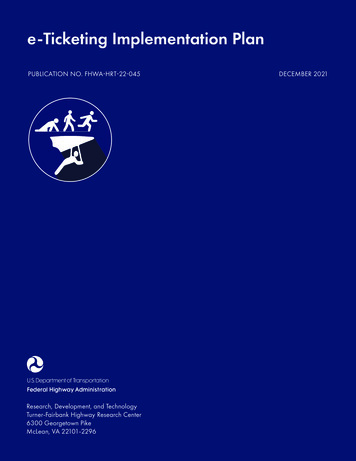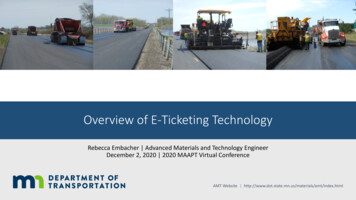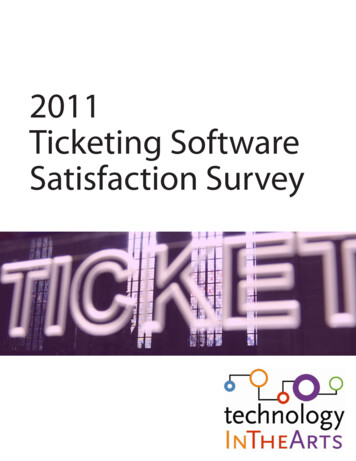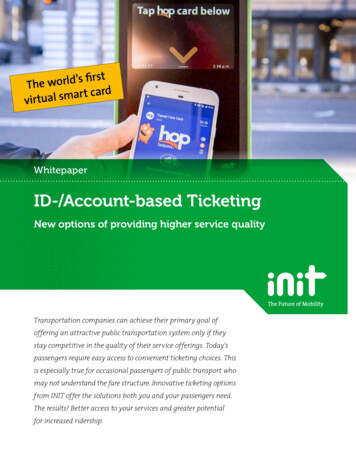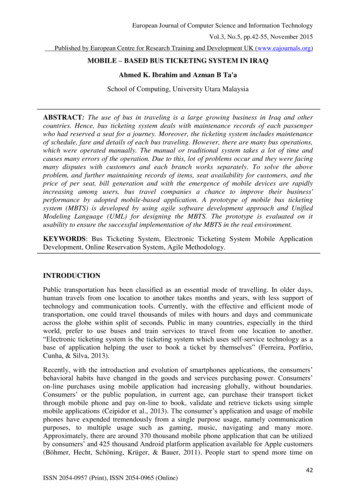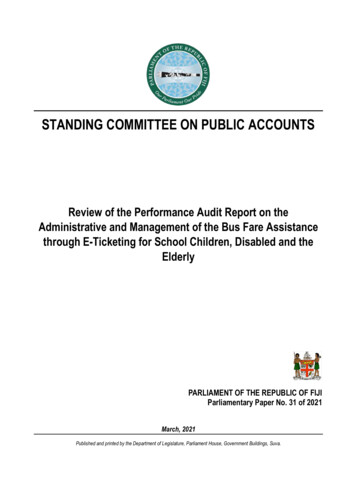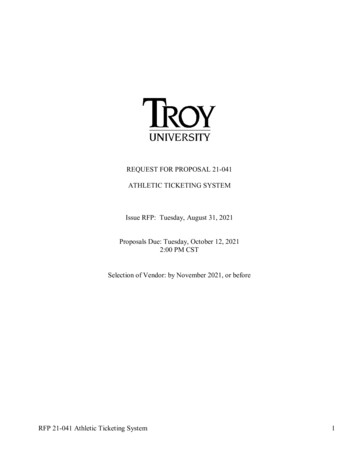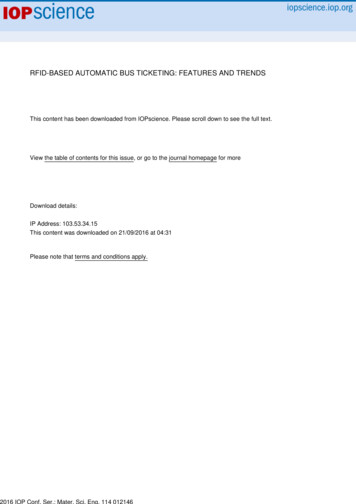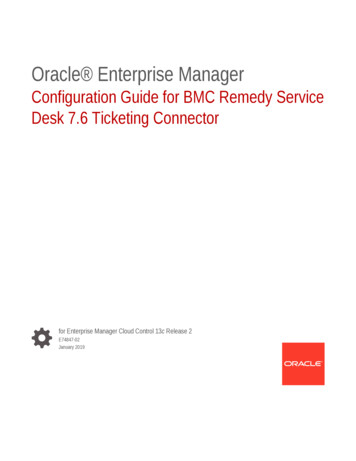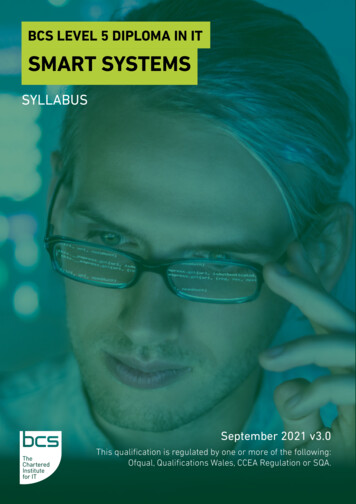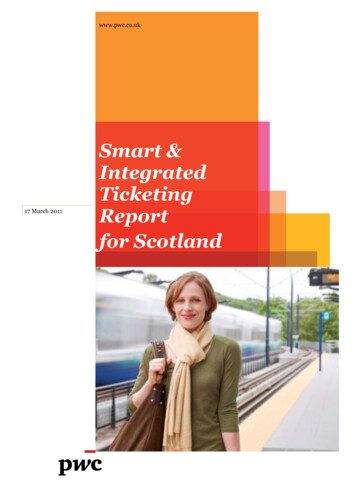
Transcription
www.pwc.co.uk17 March 2011Smart &IntegratedTicketingReportfor Scotland
This report has been prepared by PricewaterhouseCoopers LLP for Transport Scotland, with theexception of Chapter 1: Introduction which was jointly prepared and the following sections whichwere prepared by Transport Scotland: Chapter 2: Investment Case Appendix 2: Estimating the Benefits and Costs of Integrated Ticketing Appendix 3: Sensitivity Analysis for Smart and Integrated Ticketing OptionsThis report was not prepared with the interest of anyone other than Transport Scotland in mind.PricewaterhouseCoopers LLP does not accept any duty or responsibility to any other party.
ContentsGlossary of key terms11Introduction22Investment Case63Overview of the Current Position154Options Appraisal and Key Risks275Preliminary Conclusions316Affordability – the Financial Case337Achievability – the Management Case348Conclusion and the Way Forward37Appendices41Appendix 1: Further Data Sources and References Used and Reviewed42Appendix 2: Estimating the Benefits & Costs of Integrated Ticketing44Appendix 3: Sensitivity Analysis for Smart and Integrated Ticketing Options54Appendix 4: Additional Examples of Smart Ticketing Schemes59Appendix 5: Case Study on Netherlands – OV Chipkaart62Appendix 6: Multi Sports Analysis67Appendix 7: Meeting Notes from Stakeholder Interviews69Appendix 8: Possible Bus Operator Incentivisation Models70Appendix 9: Options Appraisal73Appendix 10: Output of Risk Workshop76Smart & Integrated Ticketing ReportPwC Contents
Glossary of key termsTerm / AbbreviationDefinitionAFCAutomatic Fare Collection.AMS/HOPSAsset Management and Host Operator Processing System.BSOGBus Services Operator Grant.CRMCustomer Relationship Management.DfTDepartment for Transport.EMVEuropay, Mastercard, Visa.ETMElectronic Ticketing Machine.e-purseA stored value balance on a smartcard intended for spend on a number of different servicesincluding transport.FBCFull Business Case.FSRFirst ScotRail.GMPTEGreater Manchester Passenger Transport Executive.ITSOITSO Limited is an organisation that supports, facilitates and enables the delivery of smart,integrated and interoperable ticketing across Great Britain. The abbreviation does notstand for anything; it is the name of the brand. Initially the organisation was calledIntegrated Transport Smartcards Organisation, but this was changed to just ITSO, as thescope of activity had outgrown the description implied by the name.NESTRANSTransport Partnership for Aberdeen City and Shire.NFCNear Field Communications is a short-range high frequency wireless communicationtechnology to allow cards to be read within about 10 cm of the reader.OBCOutline Business Case.PFIPrivate Finance Initiative.PTEPassenger Transport Executive.RFIDRadio Frequency Identification is a wireless communication technology which allows goodsand smart card tickets to be uniquely identified using sensors. This is applied in smartcards at ticket gates where solutions such as Oyster and ITSO cards use RFID to transactwith the gate.SESTRANSouth East of Scotland Transport Partnership.SGScottish Government.SPTStrathclyde Partnership for Transport.SYPTESouth Yorkshire Passenger Transport Executive.TfLTransport for London.TSTransport Scotland.t-purseA stored value balance on a smartcard intended for spend on transport only.Smart & Integrated Ticketing ReportPwC 1
1Introduction1.1Background1.1.1This report sets out the findings of a review conducted by Transport Scotland andPricewaterhouseCoopers LLP (PwC). The work was commissioned by Transport Scotland (TS) toadvance the TS policy towards smart and integrated ticketing. As part of the work, which wasprimarily carried out between January and June 2010, PwC was commissioned to produce an OutlineBusiness Case (OBC) for smart & integrated ticketing in Scotland.1.1.2The analysis carried out was based on HM Treasury‟s Green Book 5-case model1. PwC‟s work focusedon the current position, an options appraisal and commercial aspects (in Sections 3-8 of the report) ofsmart and integrated ticketing. Transport Scotland focused on developing the strategic andinvestment cases and is set out in Chapter 2 and Appendices 2 and 3 of the report.1.1.3The analysis considered the components of smart and integrated ticketing. The terms “smartticketing” and “integrated ticketing” are often understood in a different way by differing stakeholders,but in this report, they should be taken to mean the following, in line with DfT definitions: Smart ticketing is defined by DfT2 as where:“the ticket is stored electronically on a microchip, commonly contained in a plastic smartcard[;]tickets are checked by presenting the smartcard to a smart reader”; andIntegrated ticketing is defined in the same report2 by DfT as:“tickets [which] are valid on more than one operator and/or mode of transport [; these] do nothave to be smart tickets.”21.1.4This means, by implication, that integrated ticketing can be paper based3.1.1.5Smart, integrated ticketing combines each of the elements described in the definition above.1.1.6It is important to highlight these distinctions because, as the DfT Smart and Integrated TicketingStrategy points out:“while smart ticketing infrastructure can facilitate better regulation, it does not guarantee it[;]however, to install smart infrastructure without further integration would not realise all of thepotential benefits on offer”.41.2Policy Context1.2.1The wider policy context for the report is shaped by three dimensions in particular: The Scottish Government‟s wider economic strategy;The Scottish Government‟s National Transport Strategy; and1The focus of the OBC was based on the HM Treasury Green Book 5 Case Model‟:http://www.ogc.gov.uk/documentation and templates business case.asp2Smart and Integrated Ticketing Strategy (DfT; 2009)3The “Zonecard” in Glasgow is one such paper-based integrated ticketing scheme – allowing the user to travel on certainbus, rail, underground and ferry services, operated by Strathclyde Partnership for Transport within the Strathclyde region –depending on the number of travel zones purchased.4Smart and Integrated Ticketing Strategy (DfT; 2009)Smart & Integrated Ticketing ReportPwC 2
1.2.2The Department for Transport (DfT) Strategy for Integrated Ticketing in England and Wales.At a more practical level, the report should also be seen in the context of the progress already made inScotland in delivering elements of the infrastructure for smart and integrated ticketing.Economic Strategy1.2.3The Scottish Government‟s Economic Strategy from 2007 states that sustainable economic growth isthe central purpose of all Government activity. The Government‟s strategic objectives – to makeScotland wealthier and fairer; smarter; healthier, safer and stronger; and greener – are all predicatedon bringing about greater economic success for Scotland.1.2.4More specifically, the GES states that “an efficient transport system is one of the key enablers forenhancing productivity and delivering faster, more sustainable growth.” Underpinning this, a keytransport objective is “to provide sustainable, integrated and cost effective public transportalternatives to the private car, connecting people, places and work, across Scotland.”Transport Strategy1.2.5Scotland‟s National Transport Strategy (NTS), published in 2006, outlines three strategic objectiveswhich are focused on creating a world class transport system that contributes towards the ScottishGovernment‟s wider purpose of promoting sustainable economic growth: 1.2.6The strategy outlines the role of smart and integrated ticketing in contributing towards these threeoutcomes: 1.2.7Improved journey times and connections;Reduced emissions; andImproved quality, accessibility and affordability."We recognise the importance of the journey experience to visitors as well as commuters. Havingboth simple ticketing and better integrated services and interchanges themselves is vital. Therehave already been successful local schemes for integrated ticketing in Scotland, for example,Zonecard, Plusbus and One Ticket. We are also in the process of rolling out smart enabledticketing machines to every bus operator in Scotland, creating a platform to develop newintegrated ticketing initiatives. This will support the implementation of the concessionary travelscheme.”“We want to go further. [Our integrated ticketing strategy] will outline how to secure seamlessjourneys, between bus, ferry and / or rail journeys by different operators. We will explore thepossibility of introducing an integrated ticketing pilot across all modes in partnership with aregional transport partnership or local authority. We intend to harness the new technology andequipment that is already being progressively installed through funding provided by the ScottishGovernment across the entire Scottish bus fleet to maximise the opportunity to deliver integratedticketing. We intend to explore the possibility of extending this technology to ferries and trains.We believe this will make public transport more attractive to users and simpler to use. We willcontinue to push the boundaries of current technology to make pre-paid travel even easier forpassengers e.g. by exploring mobile phone technology. This will also speed up boarding times forall bus users.”More generally, the strategy emphasises the importance of high quality interchanges and of improvingthe overall journey experience. With Scotland hosting the Commonwealth Games in 2014, integratedSmart & Integrated Ticketing ReportPwC 3
ticketing forms part of the Scottish Commonwealth Games Legacy Plan5, though the form this takesmay well be event-specific and separate from the options outlined in this paper.Smart & Integrated Ticketing Strategy for England and Wales1.2.8The DfT published a Smart & Integrated Ticketing Strategy for England and Wales in 2009. Thisproposed that coverage throughout England and Wales could be achieved through a regional roll-outof ITSO infrastructure on buses, with the aim of covering major urban centres by 2015. DfT alsointends to progressively build in ITSO obligations into the remaining rail franchises where they arenot already specified6. In certain respects, this provides a parallel development to that beingconsidered in Scotland.1.2.9ITSO has emerged as the only practical way to achieve a secure and interoperable (e.g. betweenmodes, operators or scheme owners) smart ticketing system, particularly in the UK, where the busderegulation outside London presents particular requirements for interoperability.This has beenconfirmed by DfT in its Business Plan for 2011-20157which also addresses interoperabilitywith Oysterin London.1.2.10Whilst there are still risks and challenges with ITSO, the appointment of a new Chief Executive inearly 2010, allied to strengthening support from DfT, has led to the formulation of a forward plan thatshould see ITSO expanding, restructuring and taking greater ownership of these risks and challenges.This is particularly encouraging for the Scottish Government, which has already sunk considerablesums into ITSO infrastructure to implement smart ticketing as part of the concessionary travelscheme.Progress already made in Scotland1.2.11Transport Scotland (TS) has already delivered an important component of the infrastructure for smartand integrated travel ticketing through the Concessionary Fares Smartcard on buses. This includesaround 1.1m smartcards, 7,100 ETMs and a back office Asset Management and Host OperatorProcessing System (AMS/HOPS). In addition, First ScotRail (FSR) has piloted a season ticketsmartcard on its popular Edinburgh to Glasgow route.1.2.12Also, Strathclyde Partnership for Transport (SPT) already operates integrated ticketing products suchas ZoneCard, Day Tripper and Roundabout; there are also integrated ticket offerings from OneTicketin East Central Scotland and Plusbus. However, unlike the FSR pilot, these are all currently papertickets rather than electronic.1.2.13Whilst elements of the necessary infrastructure are already in place in Scotland, delivery of the policycommitment from Scottish Government around Smart and Integrated Ticketing would place Scotlandat the forefront of public transport systems developments worldwide, joining a small number of otherareas including London (Oyster) and Hong Kong (Octopus).5See scotland.gov.uk/gameslegacy6DfT Business Plan 2011-2015, Action 3.2, page 10, November 20107DfT Business Plan 2011-2015, Action 3.2, page 10, November 2010Smart & Integrated Ticketing ReportPwC 4
1.3Conclusion and the Way Forward1.3.1This document has been prepared to gather together and summarise the work carried out to date andto draw initial conclusions about the way forward. This allows an evidence-based assessment ofprogress and direction of travel to be made and also provides the opportunity to highlight those areaswhere further data gathering may be required.1.3.2Significant progress has been made through this project towards articulating how smart andintegrated ticketing can be taken forward in Scotland, addressing the short term developmentsneeded, the potential for a phased approach and the need to monitor ITSO development and securebuy-in to roles and responsibilities from bus operators and solution providers. In each of these areasSection 8 highlights our conclusions and next steps towards implementation.1.3.3A number of key issues for the business case have been identified, for example, concerning operatorincentivisation in a deregulated bus market and future smartcard technology evolution, on which wehave had to make assumptions. Part of our work has involved testing those assumptions throughgreater analysis and stakeholder engagement which in turn has highlighted other issues. Theresolution of these issues, summarised further in Chapter 8, will be fundamental to the successfulimplementation of smart and integrated ticketing.Smart & Integrated Ticketing ReportPwC 5
2 Investment Case2.1Introduction2.1.1This chapter is taken from the Strategic Business Case (SBC) which was prepared by the TransportEconomics, Environment, Appraisal and Research team (TEAR) in Transport Scotland. A moredetailed discussion of anticipated benefits is included at Appendix 2.2.2The Existing Evidence Base2.2.1A starting point for the development of the strategic business case was a review of the existingevidence base for smart and integrated ticketing. This evidence base is limited although two keydocuments are the business case that the DfT produced for smart ticketing and a report for thePassenger Transport Executive Group (PTEG) by Booz & Co. A summary of both reports is outlinedbelow.2.2.2The conclusion of the DfT business case is that: “On the basis of the figures presented in the tablebelow it would appear that taking in all the benefits that accrue to passengers, operators and roadusers, the introduction of smart ticketing would more than cover the up-front costs. And so long as thebenefits continue for a number of years this result holds even with a low demand and high optimismbias uplift on the capital costs. However, these results are dependent on a number of importantassumptions: Smart ticketing can achieve savings in dwell times, journey times and ticket buying times;Full take-up of smart ticketing by passengers and operators;The time gap between spending on equipment and achievement of full benefits is short;The risks of the project are successfully managed;Smart ticketing can work in a variety of market situations (or that market situations change toaccommodate smart ticketing); andOperators and Authorities can work together to produce integrated IT and back office functions.”2.2.3A report for the Passenger Transport Executive Group (PTEG) by Booz&Co.8 presents the results of adesk-top review of integrated ticketing (it did not specifically address smart ticketing) in major urbanareas in the last 40 years or so. Various impacts were assessed: patronage; revenue; modal shift;passenger satisfaction; boarding times; fraud reduction; and transaction and administration costs.2.2.4The following findings emerged: Substantial increases in patronage, in the range of 6% to 20%, with some transport modesexperiencing increases to the order of 40%;Limited evidence to support increased revenues, with the reported increase varying widely from a1% to a 12.6% increase in total revenue;Limited quantitative evidence to support a link between modal shift and fare integration, withsome case studies suggesting an overall increase in public transport usage;Some evidence to suggest improved satisfaction from fare integration primary due to increasedconvenience and fare savings;Limited evidence of faster boarding times as a result of integrating ticketing, with some transportmodes experiencing in order of a 10% reduction in passenger in-vehicle time; andThe Benefits of Simplified and Integrated Ticketing in Public Transport; Booz & Co. For PTEG(2009)8Smart & Integrated Ticketing ReportPwC 6
2.2.5Limited evidence to suggest that integrating ticketing in isolation has reduced fare evasion.Rather the reduction in fraud has usually been associated with integrated fares as well as achange in fare medium;There is only anecdotal evidence to support a reduction in transaction and administration costs fromsimplified and integrated ticketing.Table 2.1: DfT Business Case: Summary of Benefits and Costs of Smart Card ( m)High demand/ low optimismbiasLow demand/ high optimismbias.Bus annual benefits: Brackets indicate the inclusion of an uplift for consultancy and contingencyJourney time savings to existing passengers30977Ticket type benefits to existing passengers5555Operating cost savings to operators572121Concessionary reimbursement3939Fraud reduction42425510134132621275Carbon savingsSaving in surveysNew net revenue to bus operatorsBenefits to new bus usersTotalBus annual costs6666555210De-congestion7528Carbon savings428030Time saved at gates by existing passengers3221Time saved at kiosks by existing passengers147658686250165Fraud reduction5656New net revenue to rail operators855621658450Rail annual costs191191Net rail annual46725953214156221159520Bus capital costs314343 (521)Rail capital costs741853 (1231)10551197 (1752)Net bus annualCar to bus paTotalRail benefits paTicket type benefits to existing passengersSaving in ticket sales costsBenefits to new rail usersTotalCar to railDe-congestionCarbonTotalTotal net annualTotal capitalSmart & Integrated Ticketing ReportPwC 7
2.3Option Appraisal2.3.1An early, informal option appraisal process in the form of a SWOT9 analysis was undertaken byTransport Scotland to consider the following options: 2.3.2Paper based system;Smartcard based system – non ITSO compliant; andSmartcard based system – ITSO compliant.The results are shown below.Results of Initial Option Appraisal2.3.3Please note this was an early, high-level assessment and it is important to note that there have beensignificant positive developments around ITSO since it was produced.Table 2.2: Initial Option AppraisalPaper Based SystemSmartcard non-ITSOcompliantSmartcard ITSO compliantStrengthsNot reliant on technology.Deliverable subject to participatingparties agreeing business andoperating rules.Technology opens up newopportunities, Oyster isproven in London, EMV is aglobal standard, newtechnology will appeal topassengersInteroperable, secure, technologyalready rolled out across much ofScottish bus fleet and pilot onrail. ITSO already used byTransport Scotland forconcessionary travel scheme,ITSO currently supported by DfTfor both bus and rail.WeaknessesDifficult to administer effectively.Difficult to distribute revenue fairlyor quickly. Increased risks offraud/revenue protection. Does notrealise benefits of sunk costs e.g. TSAMS/HOPS. Unlikely to havepassenger appeal and so will have alimited impact on modal shift fromthe car to public transport.Oyster may not be ready orappropriate for operationoutside of London, EMV isnot yet widespread as it is apayment system rather thana platform for integration,and does not address needsof unbanked. Both systemswould require considerableinvestment for introductionin Scotland.Still a fledgling standard.Concerns over whether ITSO isgeared up to support a largecommercial ticketing systemprotection. Does not realisebenefits of sunk costs e.g. TSAMS/HOPS. Unlikely to havepassenger appeal and so will havea limited impact on modal shiftfrom the car to public transport.OpportunitiesCould be operational very quickly.Enables some synergy infuture with some largeticketing systems globally.Probably the best opportunity ofdelivering a secure smartcardbased ticketing system by 2014ThreatsPrevious and current paper basedschemes have not achievedappreciable market share. Due tothe weaknesses outlined above, thisoption is not a basis to galvanisepartners to co-operate and worktogether.Would leave TransportScotland and other Scottishpartners dependent on asingle third party supplier,which could be bothexpensive and constraining,would possibly help to stuntthe organisational growth ofITSO.Scotland continues to takeexcessive risks around unproventechnology. ITSO fails to becomeestablished as a robust basis forintegrated ticketing. Longer term– Oyster, EMV.9Strengths, Weaknesses, Opportunities and ThreatsSmart & Integrated Ticketing ReportPwC 8
2.4Rationale for Government Intervention – The Presence ofMarket Failures2.4.1The key market failure rationale underpinning the case for public sector intervention is the existenceof externalities; that is, wider social and environmental benefits, which would not solely accrue toprivate operators so that the incentives for the market to deliver a socially optimal level of provisionmay not be sufficient. These include the presence of convenience benefits to passengers in enjoyingseamless, cashless ticketing across different transport modes. Stated preference work by IPSOSMORI for the DfT which covered daily integrated tickets only, suggests that there might be somewillingness to pay extra for such a ticket but that this depends on personal and other circumstances.Moreover, qualitative results suggest that people like the idea of smart and integrated tickets, wouldtravel more if they were available, but saw them as an entitlement and were not prepared to pay morefor them.2.4.2Despite the perceived advantages of integrated ticketing it is apparent that the market is notdelivering integrated ticketing in the quantity and speed which would make the full benefits realisablefor passengers. For example, bus operators see a number of barriers to participation in integratedticketing schemes resulting in their reluctance to co-operate together to deliver such products. TheDfT Smart and Integrated Ticketing Consultation Paper10 listed the principal bus operator concernsas: Losing market share as passengers are not locked into one operator when buying a ticket;Not receiving a fair proportion of revenue from integrated tickets;Concerns about Office of Fair Trading fines for anti-competitive practices; andThe lack of freedom to set all ticket prices.2.4.3Bus operators are likely to be best placed to assess the balance of advantages and disadvantages totheir involvement in smart, integrated ticketing. But it is possible that a further market failure existsthrough asymmetric information where information is not available, in this case, to „sellers‟,preventing profitable opportunities taking place and results in a „co-ordination‟ failure, where sellersare unable to group together to „bring a product to market‟ which is in their own collective interest.The DfT consultation document11 states that “the UK Government believes that the right integratedticket products, at the right price, are what the travelling public want. As a consequence transportoperators have the ability to grow the overall public transport market and benefit all participatingoperators”. The role of Government could be to provide the information which the market is unableto make available by itself, to take a coordinating role, or to provide funding to incentivise operators‟involvement.2.5Estimating the Benefits & Costs of Integrated Ticketing2.5.1The economic analysis undertaken so far has been primarily to estimate the economic and socialbenefits from integrated and smart ticketing for Scotland across the following dimensions: 2.5.2Across two modes of transport – bus and rail12; andAcross three integrated smart ticketing options – „smart‟, „integrated‟ and „smart and integrated‟.This has been combined with estimates of the costs, both capital and operational, to extendingexisting smartcard infrastructure across the bus and rail sector in Scotland.10DfT (2009b)11DfT (2009a)SPT are considering their own smart ticket scheme. There is insufficient information at present on how smart cardinfrastructure would operate on the ferries to warrant the sector‟s inclusion in this analysis.12Smart & Integrated Ticketing ReportPwC 9
2.5.3Identifying the benefits (and to a lesser extent) the costs of a national smart and integrated ticketingscheme is challenging mainly because of gaps in the evidence base. In particular, there is noconsensus as to whether potential journey time savings will materialise. Second, there is no evidenceisolating the “convenience” benefit to passengers. The latter seem unwilling to pay for this extrabenefit, yet a review of international experience finds evidence of increases in patronage whichsuggests such a benefit exists. Most of the remaining benefits extend from these benefits. Third, it isdifficult to judge the extent to which cost savings can be realised by operators. Even where evidence isavailable, it does not typically exist separately for 1) smart, 2) integrated and 3) smart integratedticketing. Therefore the benefits are subject to a large element of uncertainty, and judgement has hadto be employed in calibrating benefits across the different ticket types.2.5.4The benefits shown in Table 2.3 reflect an appraisal period set to 11 years to reflect the technologylifespan. A standard 60 year transport appraisal period would clearly be inappropriate in thisinstance.Table 2.3: Summary Table: Economic Benefits13IntegratedSmartSmart IntegratedBus 290.4m 295.4m 373.2mRail 142.2m 148.9m 198.8mTotal2.5.5 432.6m 444.3m 572.0mThe likely costs are uncertain but the best available estimates are shown below. Capital costs arelower for integrated ticketing though the difference is primarily with respect to rail since significantinvestment in smart card technology for buses has already been made as part of the concessionaryfares programme. A key operational cost is the transaction cost charged by retailers etc for topping upcards.Integrated ticketing Capital Costs – 2.0m for combined bus and rail; andOperational Costs – 27.4m for combined bus and rail.Smart ticketing Capital Costs – 2.0m for bus; 5.5m for rail; andOperational Costs – 18.5m for bus; 4.4m for rail.Smart and integrated ticketing 2.5.613Capital Costs – 2.0m combined costs; 0.5m for bus; 4.6m for rail; andOperational Costs – 4.0m combined costs; 15.5m for bus; 2.4m for rail.Benefit-to-cost ratios (BCRs; benefits divided by costs) have been produced and are shown in Table2.4 below. Because of a lack of concrete evidence, certain assumptions have been made, for exampleabout take-up. These BCRs are highly sensitive to changes in assumptions, both in benefits and costs.In light of this a range of sensitivities has been modelled and the results are shown in Appendix 3.However, these provisional benefit cost ratios suggest that even with more restrictive assumptionsabout the extent of the benefits, there is a good case for proceeding with new ticketing arrangementsin Scotland. Net present values (benefits minus costs, discounted to give lower weight to costs andbenefits further in the future) are significant, reflecting in part the fact the existing availability ofsmart readers on buses.Discounted to 2002 in 2002 prices. Figures are rounded so may not sum.Smart & Integrated Ticketing ReportPwC 10
Table 2.4: Benefit-to-Cost Ratios and Net Present ValuesTicketing OptionBenefit Cost Ratio (BCR)Net Present Value (NPV)Integrated14.7 403.2mSmart14.6 413.8mSmart Integrated19.7 543.0mBusConvenience Benefits to Existing and New Passengers2.5.7Potential benefits include ease of use (less need to carry cash, more certain budgeting), more flexiblejourney choice of mode, route, timing, and easier interchange within and between modes.Journey Time Savings to Existing Passengers2.5.8There is some evidence that passengers using a smartcard will board more quickly than those buying aticket with cash. This benefits both the boarder and all passengers already on the bus.Operator Cost Savings2.5.9The resulting reduction in “dwell time” at bus stops due to the introduction of new ticketing productscan potentially reduce operating costs. This is possible only under certain limited circumstances, forexample, if services can be reconfigured to allow the removal of a bus from service.New Net Revenue to Bus Operators2.5.10Any new patronage will generate higher revenues for operators.Marginal External Car Benefits – Modal Shift from car to bus (excl. CO2 impact)2.5.11Any encouragement of switching from car to bus use will result in less traffic on Scottish roads whichwill result in a range of benefits, including lowering congestion and accident rates at the margin.CO2 Savings – Modal Shift from car to bus2.5.12Lower car use will tend to see carbon emissions reduce at the margin.CO2 reduction in buses2.5.13Any reduction in dwell time will have an impact of marginally reducing the CO2 emissions from buses.Fraud disbenefit2.5.14Widespread take-up of (non-smart) integrated flashcards could offer increased opportunity forfraudulent travel.Rail2.5.15Similar benefits as
ticketing forms part of the Scottish Commonwealth Games Legacy Plan5, though the form this takes may well be event-specific and separate from the options outlined in this paper. Smart & Integrated Ticketing Strategy for England and Wales 1.2.8 The DfT published a Smart & Integrated Ticketing Strategy for England and Wales in 2009. This
